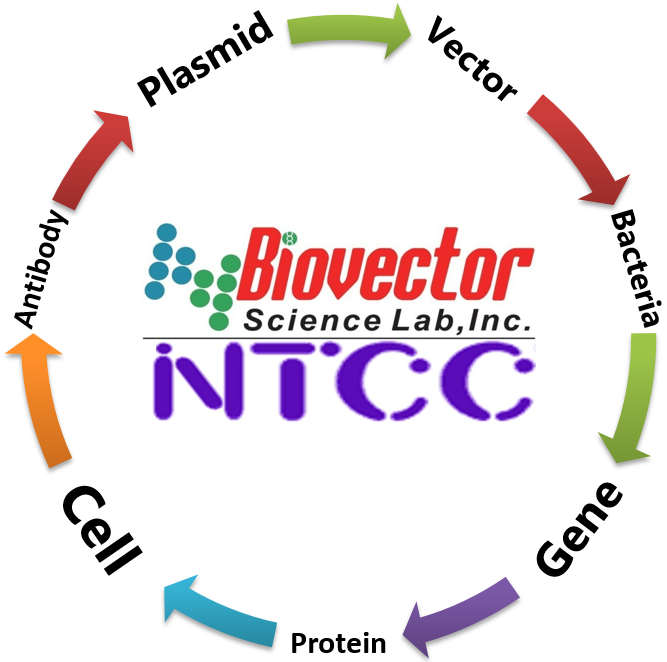BioVector's pGEX-4T-1-ERalpha-LBD雌激素受体配体结合域原核过表达质粒-Biovector NTCC典型培养物保藏中心
- 价 格:¥99860
- 货 号:BioVector-pGEX-4T-1-ERalpha-LBD
- 产 地:北京
- BioVector NTCC典型培养物保藏中心
- 联系人:Dr.Xu, Biovector NTCC Inc.
电话:400-800-2947 工作QQ:1843439339 (微信同号)
邮件:Biovector@163.com
手机:18901268599
地址:北京
- 已注册
The plasmid BioVector's pGEX-4T-1-ERalpha-LBD is a molecular construct used in molecular biology and biochemistry research, primarily for the expression and purification of the Ligand Binding Domain (LBD) of the Estrogen Receptor Alpha (ERα) protein in bacteria.

Let's break down what each part means:
1. pGEX-4T-1:
This is the vector backbone. "pGEX" stands for "plasmid for Glutathione S-transferase expression." These vectors are designed for expressing recombinant proteins as fusion proteins with Glutathione S-transferase (GST).
GST tag: The GST tag (from Schistosoma japonicum) is approximately 26 kDa and is fused to the N-terminus of your protein of interest (in this case, ERα-LBD). This tag allows for easy purification of the fusion protein using Glutathione Sepharose affinity chromatography. GST-tagged proteins bind strongly to glutathione, enabling their separation from other bacterial proteins.
4T-1: This indicates the specific series and reading frame of the pGEX vector. The "4T" series vectors (like pGEX-4T-1, pGEX-4T-2, pGEX-4T-3) contain a thrombin cleavage site located between the GST tag and the multiple cloning site (MCS). This is crucial because, after purification, the GST tag can be precisely removed from the target protein using thrombin protease, leaving the native protein of interest. The "-1" signifies a specific reading frame in the MCS, ensuring that the inserted gene is translated correctly.
Tac promoter: The expression of the GST fusion protein is driven by the strong
tacpromoter, which is a hybrid between thetrpandlacUV5 promoters. This promoter is inducible by IPTG (isopropyl-β-D-thiogalactopyranoside), allowing for controlled expression of the protein.lacIqgene: This gene encodes thelacrepressor protein, which binds to thelacoperator within thetacpromoter, keeping expression repressed until IPTG is added. This helps prevent the expression of the foreign protein from becoming toxic to the bacterial host.Ampicillin resistance gene (AmpR): This gene provides resistance to the antibiotic ampicillin, allowing for selection of bacteria that have successfully taken up the plasmid.
Origin of replication (ori): Enables the plasmid to replicate in E. coli.
2. ERalpha-LBD:
ERalpha (ERα): This refers to the Estrogen Receptor Alpha, a key member of the nuclear receptor superfamily. ERα is a ligand-activated transcription factor that plays a crucial role in mediating the effects of estrogen hormones in various biological processes, including reproductive development, bone health, and the progression of certain cancers (like breast cancer).
LBD (Ligand Binding Domain): This is a specific functional domain of the ERα protein located at its C-terminus.
Function: The LBD is responsible for binding to estrogen and other ligands (both natural and synthetic, such as anti-estrogens like Tamoxifen).
Conformational Change: Upon ligand binding, the LBD undergoes a conformational change, particularly in helix 12, which is critical for regulating the receptor's activity.
Coregulator Recruitment: This conformational change enables the LBD to recruit various coactivator or corepressor proteins, thereby influencing the transcription of target genes.
Therapeutic Target: The LBD of ERα is a major therapeutic target for drugs used in the treatment of hormone-sensitive breast cancers.
Overall Function of pGEX-4T-1-ERalpha-LBD Plasmid:
The pGEX-4T-1-ERalpha-LBD plasmid is designed to:
Express the Ligand Binding Domain of Estrogen Receptor Alpha as a GST-fusion protein in E. coli.
Allow for efficient purification of this fusion protein using glutathione affinity chromatography.
Enable the cleavage of the GST tag from the ERα-LBD using thrombin protease, yielding a purified, untagged ERα-LBD.
Applications:
This plasmid is widely used in research for:
Structural Biology: Producing purified ERα-LBD for crystallography or NMR studies to determine its three-dimensional structure and how it interacts with different ligands.
Ligand Binding Assays: Studying the binding affinity of various natural and synthetic compounds (estrogens, selective estrogen receptor modulators/SERMs, antagonists) to the ERα-LBD.
Drug Discovery: Screening for new drugs that modulate ERα activity by targeting its LBD, which is critical for developing new treatments for breast cancer and other estrogen-related diseases.
Biochemical Characterization: Investigating the biochemical properties of the ERα-LBD, such as its dimerization, conformational changes, and interactions with other proteins (e.g., coactivators).
Functional Studies: Although typically for in vitro studies, the purified LBD can be used to understand the molecular mechanisms underlying ERα signaling.
Biovector NTCC典型培养物保藏中心
- 公告/新闻




